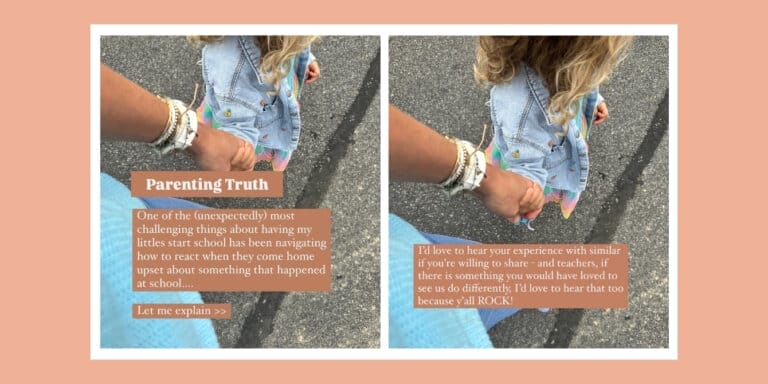10 tips from a teacher for making virtual school work

Photability/Twenty20
And they're all totally doable. For real.
We independently select and share the products we love—and may receive a commission if you choose to buy. You’ve got this.
Table of Contents
- 1. Check your attitude.
- 2. Create workstations.
- 3. Set your kids up for success.
- 4. Ask kids what they think will help them.
- 5. Teach kids how to get (and stay) organized.
- 6. Post individualized positive affirmations.
- 7. Use emojis for quick check-ins.
- 8. Involve the neighborhood in outdoor time.
- 9. Establish clear expectations for screen time.
- 10. Communicate with the teacher.
- Tackling distance learning at your house this fall? We've got some products that can help.
Parents are on edge this school year, not knowing what to expect with distance learning—or perhaps we’re just remembering all too well the many challenges of distance learning last spring.
The nature of the COVID beast means that information is changing rapidly, and so are all the plans guided by that information… including school. This wait-until-the-last-minute way of living has been nerve-wracking to say the least, especially for those of us parents who rely on a color-coded schedule for each day to keep things moving smoothly.
As an educator and a mom of three, I knew I needed to try something different this fall to help set all of us up for a better experience with distance learning.
Here are a few tips that can help make the start of virtual school go a little smoother.
1. Check your attitude.
I know this is hard. Big time hard. Trust me. I have been in the house with three very active kids since March, and if I could safely send my kids to school, I would love nothing more than a day of peace and silence. But until it’s safe to go back, make sure you project a positive attitude in front of your kids. This is a great opportunity to model how your family deals with difficult situations and overcomes challenges. I am not saying pretend everything is fine, but do try to keep your frustrations and anxieties from influencing your child’s view of distance learning. Remember they are always listening and watching.
2. Create workstations.
I definitely went down the Pinterest rabbit hole with this one, but then I remembered my new life mantra: simplify, simplify, simplify. The best remote-school work space is a desk or table, preferably near natural sunlight, with a few sheets of paper and plenty of sharpened pencils. We know that our rising fourth grader can work independently in his room so our dilemma was figuring out where to set up our rising first grader. While he could work next to dad in the office, we all know that means nobody would get much of anything done. If we set him up at the dining room table, I would have to keep the toddler away from him all day so that’s a big not-gonna-happen. We decided that he would be able to focus best if he also works in his room at his own desk where I can still check on him without the toddler making a surprise Zoom appearance.
3. Set your kids up for success.
Is your child a little wiggle worm who struggles to sit still for longer periods of time? Consider getting an exercise ball or a wiggle pillow. (We set clear expectations for these two items.) Make sure to allow for time before school starts for kids to be able to get used to these new “toys.” Losing some of the novelty will hopefully keep kids from bouncing on the ball too much (wishful thinking?). Since our boys are very, very active, setting them up for success also involves being physical before classes start. We live in a neighborhood that spans an .8 mile circle, which is just the right amount for my kids to jog twice. Though they complain about having to do this, they always return in a better mood and more awake than when they left.
4. Ask kids what they think will help them.
My boys requested play-doh, fidget spinners and a zen garden. They know that they need something in their hands and these are ways that they can engage in sensory work while still paying attention to their teacher. As a teacher, it was difficult for me watching my kindergartener build Lego during his Zoom session. He didn’t “look” like he was paying attention—but he was. He even cried on the last day of his summer class. It was an important reminder for me that paying attention looks different for each kid.
5. Teach kids how to get (and stay) organized.
Pin passwords and Zoom log-in information right on their desk where they can see it. This will alleviate the frustration of trying to log into various Zooms and not remembering each teacher’s information. Then, show your kids that when classes are done for the day, they need to have a spot for their homework and folders for their various subjects. Everything needs to have a spot and their space should be tidied up each day. I have found that my kids often don’t know what I mean when I say “tidy” so I try to be as specific as possible. “Pencils and pens belong in the pencil holder” or “Homework goes in this folder so it doesn’t get lost” is clear and specific.
6. Post individualized positive affirmations.
I have seen sheets of affirmations that can easily be printed offline but the best ones are the ones made with your child. At the beginning of each baseball training session, my husband asks my boys to yell “I CAN DO THIS!” Though it took me some getting used to this yelling, I quickly saw the benefits and effects. My 6-year-old’s confidence was increasing session after session and missed hits did not lead to melt-downs anymore. Create a sheet of positive statements with your child that they will read daily and start to internalize.
7. Use emojis for quick check-ins.
Communicating feelings can be tricky, especially when the feeling is not straightforward. Especially when it comes to things like Zoom fatigue, I know I need to equip my kids with new terminology so they can express themselves. Putting a piece of paper with a variety of emojis in a clear sheet allows kids to circle the picture of how they are feeling. This can be wiped down daily (or hourly) and used again the following day. Even if my kids don’t know what they need and can’t put a name to the feeling, it’s helpful for me to see what they have circled.
8. Involve the neighborhood in outdoor time.
I am thrilled that our local elementary school decided on a long lunch break, from 11:30 am to 1 pm. That gives kids enough time to eat and then play outside from 12-1 pm. We are hoping to set up some kind of neighborhood rotations that would allow kids to play safely outdoors in different yards during this “recess” time. If that idea doesn’t come to fruition, I know my kids will be riding bikes and playing outside during this hour.
9. Establish clear expectations for screen time.
In order to avoid melt-downs in regards to screen time, we have been up front with our kids that things will change once the school year gets started. Since the majority of the day will be spent in front of screens, video games will have to wait until the weekend. Of course, they balked at this change of their routine, but at least now they have a few more days to get used to this change.
10. Communicate with the teacher.
Although I have been a teacher for over a decade, I still get nervous about how my kids will do in other classes. As if my kids will be the only ones who struggle with distance learning. I know better. Yet, talking to my friend who teaches elementary school made me feel so much better. I just needed to hear what I already knew from another teacher. Of course the teachers will be understanding, of course the teachers will work with my kids, of course my kids aren’t the only ones who will get off track. Teachers are super nervous and I know from my various online teacher groups that they, as always, just want to be the very best for your child. Partner with your child’s teacher. And let’s all remember to go into this bizarre school year ready to show our kids, our teachers and selves some grace.








































